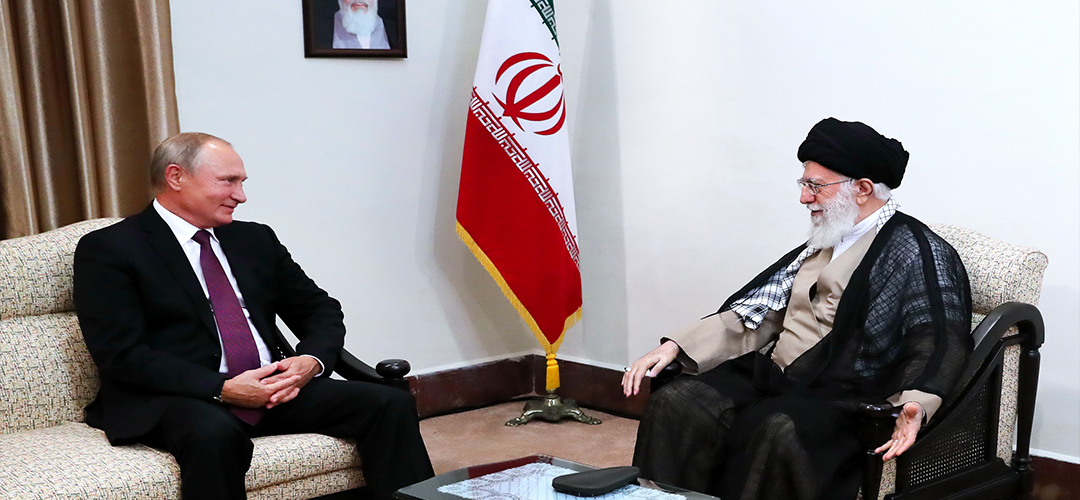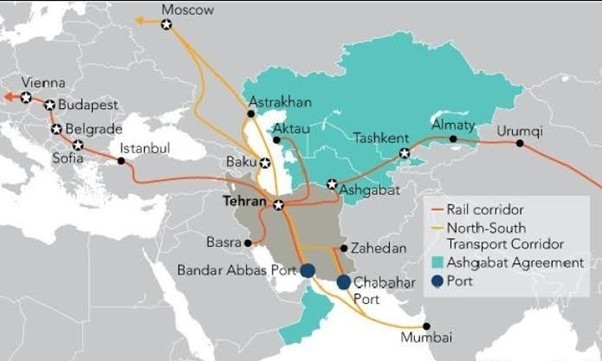Russia-Iran: a Sanctions Proof Corridor
May 5, 2023 | Expert Insights

Iran has the dubious distinction of being under crippling economic sanctions since the emergence of the Islamic Republic of Iran after the 1979 revolution. While the sanctions have been relaxed, removed, re-imposed, strengthened and doubled, from time to time as per the whims and fancies of the Western alliances, the stoic Iranians, the proud inheritors of the mighty Persian Empire, have learnt to live with this encumbrance. Now they have a powerful co-sufferer who joins the duo of Iran and North Korea-Russia.
A natural fallout of the coming together of Teheran and Moscow would be trying to find a bypass to the stranglehold of the sanction’s regime. Billed variously as a ‘sanctions avoidance corridor,’ a ‘Russia-Iran Corridor’ or International North-South Transport Corridor (INSTC), this initiative offers new economic opportunities not only to the two principal protagonists but also to a score of countries that will provide them a safe corridor.
Background
The idea of a trade corridor linking the Caspian Sea to the Indian Ocean is not new and has been fleetingly considered by many. However, it has gained currency in last few years as increasing number of countries fell threatened by the power of the West to punish them economically if they flout the rules of engagement set by the West. Russia’s economic and geopolitical ostracization after its invasion of Ukraine has given an impetus for Russia to link hands with Iran by seeking a circuitous route through Central Asia to avoid areas where Western sanctions make the flow of trade goods difficult, if not impossible.
One option is to go through Kazakhstan and Turkmenistan with Russia upgrading its ports on the Caspian sea utilising Iranian investments and allowing access to Iranians ships into its ports. With Russian expertise, a 165 km railway link is being constructed through Iran to connect its border with Azerbaijan on the Caspian Shore. Therefore, is it surprising that Armenia’s security guarantor for Nagorno Karabakh- Russia- has really not been able to restrain Azerbaijan in securing a vast swathe of territory in the disputed enclave and in recent times choked Armenian access to the enclave through the Lachin Corridor? Once completed, freight trains well roll from the Baltic to Bandar Abbas on the Persian Gulf unimpeded.
A more ambitious version of the this is the International North-South Transport Corridor (INSTC), which is around 7000 km long and is a mix of roads, rail and shipping routes connecting Mumbai to Russia via Iran and Central Asia.
There are several options for the corridor to connect Russia with India. One is the Trans Caspian route which is largely dependent upon the existing shipping lanes. A Western branch follows the western coast of The Caspian Seal along Russian and Azerbaijan territory. Its Eastern branch is through Turkmenistan and Kazakstan, along the eastern coast of Caspian.

Analysis
While the INSTC is the only hope for both Iran and Russia to expand their trade and survive economically, the realisation of this dream is full of challenges.
For one, there is a long-standing enmity between Azerbaijan and Teheran, despite both being Shia nations. In fact, they have both conducted military demonstrations along their mutual frontiers along the Aras River frequently. Iran has cajoled Turkey ( which enjoys excellent relations with Azerbaijan having helped them win the spectacular victories in 2020 in Nagorno Karabakh) to act as a go-between and in a series of meetings held in Turkey, some differences were reportedly settled. After all, Baku too stands to gain tremendously from the transit charges as trade grows in volume along this corridor. As per President Aliyev of Azerbaijan. The volume can b e as high as 30 million tons.
While both Moscow and Tehran have already committed vast investments into the corridor, they are handicapped because a project of this magnitude needs international investment at a huge scale and their international isolation makes them extremely risky investment options. Ultimately, the regional network will cost at least $25 billion. Tehran is already scouring the world to increase its merchant shipping fleet so that it can establish a continuous sea link along the Caspian transportation network. Iran’s Bandar Abbas will feature majorly in the corridor taking the shape of a transport-logistics hub.
Russia on its part is not very comfortable with a corridor that has a sea borne leg as it is aware of its lack of capability in the maritime domain as compared to the powerful Western navies; it would prefer a land link in its entirety.
Another area of concern is provision of security along the entire stretch of the corridor which passes through large stretches of uninhibited and difficult terrain that are generally lawless. For example, the disruptive region of Dagestan will have to be bypassed as its inhabitants are rabidly anti-government and separatist tendencies against the Russian Federations have never been far from the surface.
The ultimate market being targeted by this corridor is India. The question arises whether India can afford to annoy the West if allows goods to flow through this sanction-proof corridor from Russia through Iran? Let alone India, few countries in the region would be willing to expose themselves by trading through transit hubs controlled either by Moscow or Tehran.
Assessment
- While INSTAC is attracting a lot of media attention, on ground it does not appear to be anything more than aspirational. The Western powers are not beneath sabotaging the whole deal using political coercion, sanctions and even downright physical sabotage- look at the destruction of the Nordstream pipeline!
- While to Moscow it may be seeking alternate routes to its earlier European trade routes which are no longer accessible, but even for trading countries like India, the cost of transport will be reduced as the high cost of Suez Canal fees will no longer be applicable. Of course, Egypt will not be happy being deprived of this precious revenue.








Comments